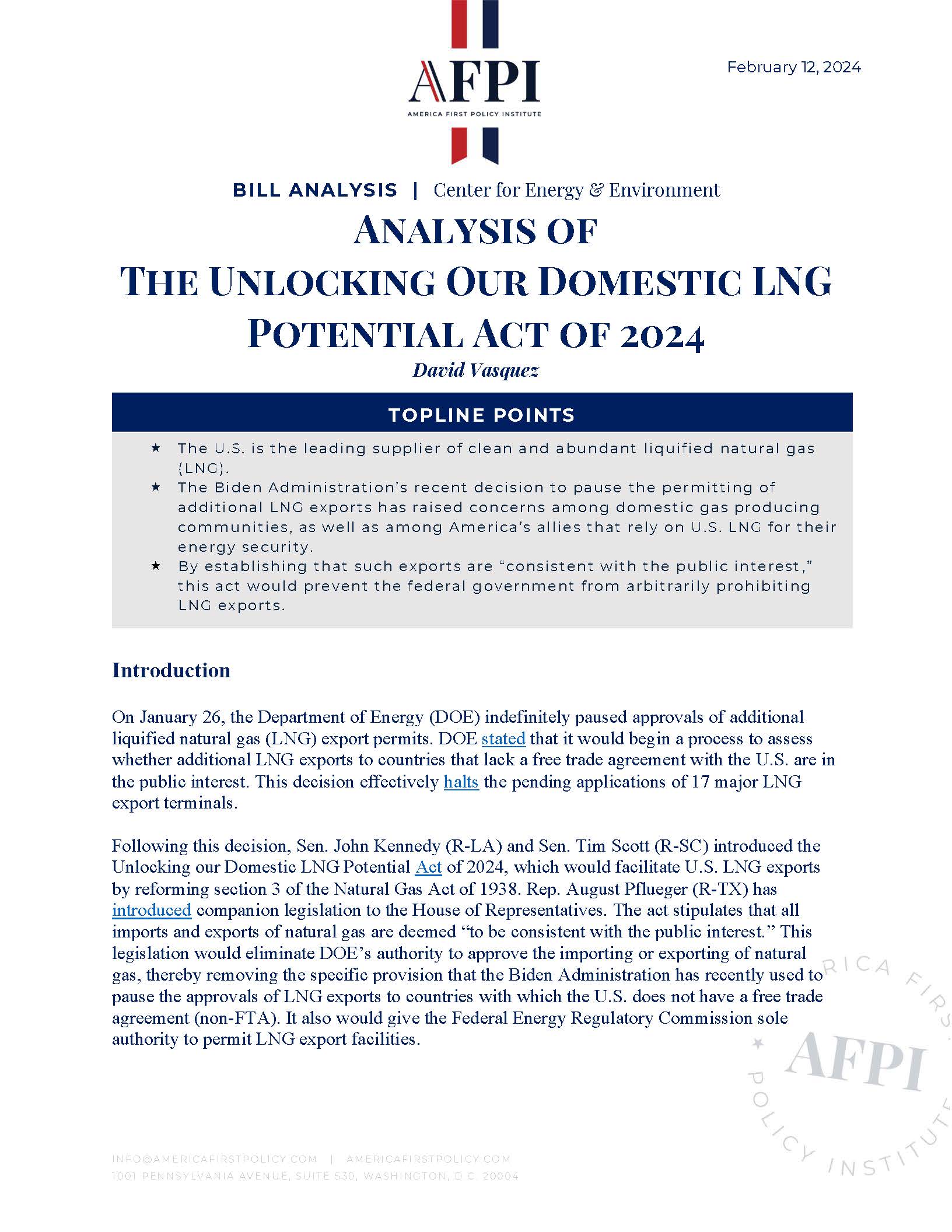Analysis of The Unlocking Our Domestic LNG Potential Act of 2024
Key Takeaways
The U.S. is the leading supplier of clean and abundant liquified natural gas (LNG).
The Biden Administration’s recent decision to pause the permitting of additional LNG exports has raised concerns among domestic gas producing communities, as well as among America’s allies that rely on U.S. LNG for their energy security.
By establishing that such exports are “consistent with the public interest,” this act would prevent the federal government from arbitrarily prohibiting LNG exports.
Introduction
On January 26, the Department of Energy (DOE) indefinitely paused approvals of additional liquified natural gas (LNG) export permits. DOE stated that it would begin a process to assess whether additional LNG exports to countries that lack a free trade agreement with the U.S. are in the public interest. This decision effectively halts the pending applications of 17 major LNG export terminals.
Following this decision, Sen. John Kennedy (R-LA) and Sen. Tim Scott (R-SC) introduced the Unlocking our Domestic LNG Potential Act of 2024, which would facilitate U.S. LNG exports by reforming section 3 of the Natural Gas Act of 1938. Rep. August Pflueger (R-TX) has introduced companion legislation to the House of Representatives. The act stipulates that all imports and exports of natural gas are deemed “to be consistent with the public interest.” This legislation would eliminate DOE’s authority to approve the importing or exporting of natural gas, thereby removing the specific provision that the Biden Administration has recently used to pause the approvals of LNG exports to countries with which the U.S. does not have a free trade agreement (non-FTA). It also would give the Federal Energy Regulatory Commission sole authority to permit LNG export facilities.
While more reform is needed to ensure that the federal government is leveling the regulatory playing field for all sources of energy, this act is a good and necessary step in the right direction. Below are three key provisions of reform that this bill would address.
Approval Times
Currently, the U.S. is the world’s largest provider of LNG, having exported 88.9 million metric tons (MT) in 2023. The growth of the LNG industry comes as a direct result of deregulatory reforms made during and throughout the Trump Administration. The landmark reforms to the National Environmental Policy Act and other consequential regulatory reforms dramatically reduced the overall time to review and approve applications for LNG terminals. Under the Trump Administration, the average time to review and approve LNG terminals fell from 155 days to 49 days. The Biden Administration, by contrast, has increased the review and approval time to 330 days for each LNG terminal.
Capacity Additions
The amount of foregone LNG export capacity associated with the Biden Administration’s permit pause is significant. According to the latest data from the Energy Information Administration, the U.S. LNG Export Capacity is 11.4 Bcf/d at the moment. Developing already permitted projects in the U.S. would raise that export capacity to 21.1 Bcf/d. The majority of the 17 proposed projects that have export permits pending DOE approval will be significantly impacted by the pause. According to analysis from Wood Mackenzie, “…there are almost 90 mmtpa (approx. 12.06 Bcf/d) of projects awaiting non-FTA approval…. Without non-FTA approval, these projects will struggle to gain sufficient backing to proceed.” If the Biden Administration’s pause remains in effect, the U.S. will effectively lose one-third of the current potential of increased LNG export capacity.
This supply increase is necessary to meet the growing demand for North American LNG, a demand that is set to increase by 60% (48 million MT) by 2026. Global LNG demand also is expected to increase to more than 700 million MT by 2040. For reference, the U.S. currently has an export capacity of nearly 90 million MT (approximately 12.06 Bcf/d). If the U.S. were allowed to develop its LNG capacity fully, the U.S. could reach 238 million MT (approx. 31.74 Bcf/d) by 2050, which would allow the U.S. to meet more than 30% of global demand for LNG.
Economic Growth
Reducing the permitting backlog in the LNG industry and prioritizing the development of future LNG terminals has the potential to create excellent economic growth. Industry estimates find that between 2025 and 2030, the U.S. could add $63.1 billion in new capital expenditures, $46 billion in GDP contributions, and 429,000 more jobs.
Moreover, the U.S. Energy Information Administration estimates that increased LNG exports have had a negligible effect on the price of domestic LNG. By increasing LNG export capacity, the U.S. can support the increased demand for international energy and domestic prosperity without sacrificing the affordability of LNG for Americans at home.
Conclusion
The Unlocking Our Domestic LNG Potential Act of 2024 is a pro-growth act that works to unleash the potential of the U.S. energy industry. It constitutes an important step toward leveling the regulatory playing field for all sources of energy to compete, thereby facilitating the development of domestic economic prosperity and American energy dominance.
